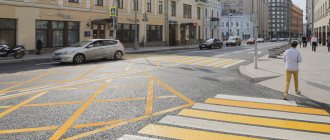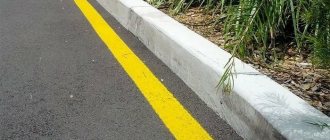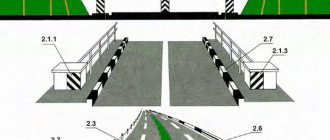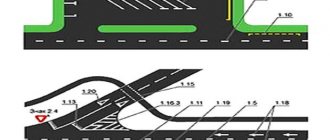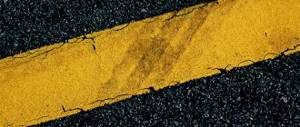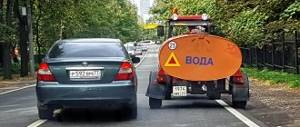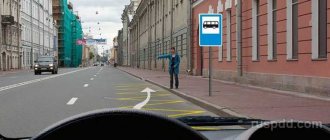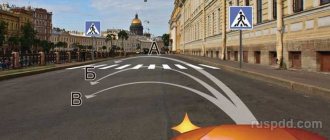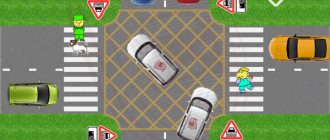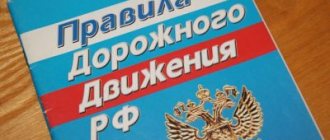As our country prepares to host the FIFA World Cup in 2021, significant transformations are taking place in many cities. Road surfaces of the main routes are being repaired, roadways are being widened, modern interchanges and elevated pedestrian crossings are being built. Of course, these changes are important and necessary. But at the time of repair, you have to endure many inconveniences and get used to new traffic rules on some sections of the road.
Such rules are determined by time markings, which become the main ones and must be observed. Read on to find out what the fine is for non-compliance with temporary markings.
We give concepts
In accordance with clause 1.3 of the traffic rules, approved by Government Decree No. 1090 of October 23, 1993, everyone who moves - motorists, cyclists, motorcyclists and even pedestrians - is required to follow the rules, follow the instructions of signs, markings, traffic lights or traffic controllers. Anyone who violates traffic rules bears responsibility established by the Code of Administrative Offenses or the Criminal Code.
According to Appendix 2 of Government Decree No. 1090 of October 23, 1993, road markings can be horizontal or vertical. The horizontal one, in turn, is divided into permanent - this is the one that is applied for permanent use, and temporary - this is the one that is painted in areas where repair work is carried out, if the period for their implementation exceeds a period of 3 days.
The procedure for applying temporary markings is regulated by GOST R 52289-2004, which states that it should be drawn in accordance with the location of the fences and objects used, which will additionally ensure a change in the flow of vehicles. In addition, in addition to the lines, you should use cones or plates of bright colors.
GOST R 51256-99 requires the use of materials for drawing lines on asphalt so that they can be quickly demarcated. The act provides for the determination of the color of temporary markings on the road. It should be orange in color, but in practice the color varies from red to yellow. The use of colors that attract attention is not accidental; the driver must see that new rules must be followed on this section of the road.
Please note that there are 3 options for permanent markings, which are painted in yellow.
It is important to remember that they are considered permanent and cannot be canceled over time. These include:
- 1.4, is a solid yellow line placed at the edge of the road or on the curb. Such markings warn that stopping is prohibited. It is usually used in combination with sign 3.27, which duplicates the prohibition;
- 1.10 represents dashed yellow lines, also placed at the edge of the roadway or on the curb; parking is not allowed here, that is, in fact, this area can be used for stopping. The marking is usually duplicated by the sign 3.28.
- 1.17 also drawn in yellow, this is a broken line that indicates places where stationary stops are provided for public transport or passenger taxis.
What are the markings on the road according to traffic regulations?
Orange traffic markings on the road are temporary. It is valid for a certain period when the travel features of a section of the track need to be changed. The reason for the orange markings is due to repairs to the road surface and construction going on nearby. The lines may indicate the need to bypass the area, prohibit maneuvers, limit speed, etc. That is, not only the color matters, but also the features of the design he made.
- Determine your lane by eye. If the road is not wide, you need to mentally divide it lengthwise into two parts. The median line can be either solid or broken. But since the driver does not see this, it is permissible to overtake here, and he should not be fined.
- On a multi-lane road, the center marking line will definitely be double solid. And here, despite poor visibility, you cannot cross it.
- In the absence of markings on a wide road there are only an even number of lanes, but not three. In accordance with this, you need to move along it. That is, if you drive straight through the center, it will be a gross violation of the rules.
Possible violations and liability for them
Responsibility for violation of the requirements imposed by markings is established in the Code of Administrative Offenses, and the code does not divide the amount of punishment for violations of recommendations given by permanent or temporary markings.
Crosswalk
Sometimes, due to major road reconstruction, a temporary relocation of the pedestrian crossing occurs.
A rule will apply to it: stopping or parking on it, or performing the same actions in front of it at a distance closer than 5 meters is prohibited. This type of offense is punishable by Part 3 of Art. 12.19 of the Administrative Code in the amount of 1000 rubles. If the driver leaves the car, the traffic police officer may decide to evacuate the vehicle.
Therefore, in addition to a fine for violating traffic rules, an inattentive driver will also have to pay for the services of a tow truck and the cost of a parking lot. Federal Law No. 143 of 06/08/2015 added an additional clause to Art. 27.13 of the Administrative Code, which regulates the evacuation procedure.
According to the innovation, if the driver of the car appears at the time of drawing up the protocol or loading it onto a tow truck, but before it starts moving, the vehicle must be handed over. But sanctions for violating traffic rules will still be applied.
Driving through the intersection
When crossing a controlled intersection, that is, one where traffic is regulated by traffic lights or gestures of a traffic controller, you need to pay attention to the presence of markings 1.12. It alerts drivers to stop immediately in front of it and is called a “stop line.”
In accordance with clause 6.13, if there is such a line at an intersection, the driver must stop in front of it when required by a traffic light or traffic controller.
For violation of this rule, liability is established under Art.
12.12 Code of Administrative Offences, in the amount of 800 rubles. This marking is also used in conjunction with sign 2.5 “Driving without stopping is prohibited.” It's a red octagon with the word "STOP" written on it. In addition to intersections, both controlled and not, it can be installed in front of a railway crossing.
Liability for violating the markings that exist together with the “STOP” sign will depend on the place where it was committed. If the violation occurred at an intersection, then this act is qualified under Part 1 of Art. 12.16. Then you will have to pay 500 rubles to the treasury. True, the norm provides for another version of liability - a warning.
The need to stop when approaching the railway tracks is established by clause 15.4 of the traffic rules. If the violation occurred before the railway crossing, then it is already qualified under Part 2. Art. 12.10 of the Administrative Code, which determines the penalty in the form of an administrative fine of 1000 rubles without offering an alternative option.
Solid
Crossing solid 1.2 marking the edge of the roadway, followed by driving along the side of the road, is punishable in accordance with Part 1 of Art. 12.15 Code of Administrative Offenses, a fine of 1,500 rubles.
If marking 1.23.2, indicating a path for pedestrians, or 1.23.3, defining a place for cyclists where motorists are prohibited from moving, is not followed, then those who violate this rule will have to pay 2,000 rubles.
Crossing a continuous road, if the driver drives into oncoming traffic, will be punished differently, depending on the reasons for this maneuver.
If this was done to avoid an obstacle, then the amount of liability is limited only by a fine and varies from 1000 to 1500 rubles. An obstacle, in accordance with clause 1.2 of the Traffic Regulations, is considered to be any object or defect in the road surface that appears on the path of movement.
Please note that a traffic jam is not considered an obstacle. Therefore, if you decide to go around it in the oncoming lane, and even crossed a solid line, then be prepared for the fact that more serious liability is provided for this violation.
You may either be fined 5,000 rubles or be deprived of the right to drive a vehicle for a period of 4 to 6 months.
If this offense was committed again, you will have to part with your rights for a year. But if you are held accountable based on data from cameras recording offenses on the road, then you can only be ordered to pay a fine of 5,000 rubles.
If a continuous line is crossed as a result of a left turn or a U-turn, then liability arises under Part 2 of Art. 12.16 Code of Administrative Offences. Special attention must be paid to this circumstance, since inspectors often try to apply the more severe punishment described above when committing this violation. But in this case, we can only talk about collecting an administrative fine from 1000 to 1500 rubles.
Bus Lane
The letter A may be drawn on the road, which corresponds to the marking number 1.23.1.
Together with signs 5.11.1, 5.13.1, 5.13.2, 5.14, it indicates the allocation of a specialized lane for public transport and passenger taxis. However, in this case it is also necessary to pay attention to the signs installed nearby. The fact is that the allocation of a band may not always occur, but only at a certain time.
If this is the case, then additional information signs will be installed nearby to notify about the duration of the ban. For example, the restriction may apply only to working days or only to specific hours on certain days.
Failure to comply with the requirements for granting the right to move freely along a specialized lane for public transport is punishable in accordance with Art. 12.17 of the Code of Administrative Offences, a fine of 1,500 rubles, and if the same actions were committed in Moscow or St. Petersburg, then it is doubled.
What does a yellow line mean on the road in Russia?
Deterioration in health If, for health reasons, further control of the vehicle is impossible, then the driver has the right to stop in the area where the prohibiting sign is active Vehicle malfunction In the event of an unexpected breakdown of the vehicle without further possibility of movement, it is allowed to ignore the markings Other cases When further movement is impossible through no fault of the driver or the vehicle (for example , road accident), the driver also has the right to stop the car in an area with a prohibitory graphic sign, provided that there are no other options for bypassing or parking the vehicle
Interesting to read: Is façade repair a major overhaul or a routine one?
Crossing a solid line In cases of crossing a solid orange stripe (single or double) separating oncoming traffic, liability is provided under Parts 3–4 of Article 12.15 of the Code of Administrative Offenses of the Russian Federation. Upon violation, a fine of 1,500 rubles is determined. when crossing a double continuous line in order to avoid an obstacle, as well as 5,000 rubles. or deprivation of rights for up to six months in other cases. Driving on the side of the road If you ignore traffic rules in the area of a prohibitory sign operating on the basis of a yellow stripe at the edge, it is regarded as driving on the side of the road and is subject to a fine of 1,500 rubles. (Part 1 of Article 12.15 of the Code of Administrative Offenses of the Russian Federation)
Controversial situations
The traffic rules, in Appendix 2, determine whose instructions have priority. The norm establishes the rule that if permanent markings contradict signs, then it is necessary to be guided by the requirements imposed by the signs.
If a contradiction arises between temporary markings or signs, as well as temporary markings or permanent markings, then the recommendations of the temporary markings must be followed. It will determine the traffic rules that must be followed when repair work is carried out on the road.
Unfortunately, there are often situations when the work has been completed, but the temporary markings are not demarcated. In order to avoid liability and subsequent trips to the courts to appeal the decision, you must continue to use the yellow lines.
Of course, if they do not contradict common sense or, for example, do not force you to enter a lane where cars are moving in the opposite direction. In addition, if the road workers did not erase the temporary markings, and they clearly mislead you and other road users, then you can complain. To do this, you will need to write an application to the traffic police.
If you are held accountable for violating temporary markings, while you are absolutely sure that you followed the traffic rules, the decision made against you can be appealed. To do this, you must have sufficient evidence for the court to take your side - data from your video recorder, information that the work was completed long ago, accompanying signs were removed, and the markings were not erased, etc.
What do orange markings on the road mean?
At the same time, GOST provides for the drawing of lines that separate streams and separate roadsides in white or yellow. These lines are of great importance for traffic safety, and these colors are the most visible on the road. It is even proposed to paint yellow markings in those places where overtaking is prohibited, for greater visibility. And for secondary markings, which indicate, for example, parking spots or directions of movement at intersections, the color blue will be used.
1.11 — separates traffic flows of opposite or similar directions on sections of roads where changing lanes is allowed only from one lane; designates places intended for turning around, entering and exiting parking areas, and the like, where traffic is allowed only in one direction;
What do orange markings on the road mean?
Indicative arrows determine the permitted directions for vehicles to move along the lanes at an intersection. This marking is used both independently and in combination with signs 5.8.1, 5.8.2 (direction of traffic along lanes, lanes). Marking 1.18 helps drivers timely occupy the appropriate lane in the desired direction. Arrows that allow a left turn from the leftmost lane also allow a U-turn. Markings depicting a dead end are applied in front of an intersection that has several roadways, where turning onto the nearest roadway (in the direction of the designated dead end) is prohibited.
For example, on turns, a dashed line turns into a solid line is used to prevent the driver from driving into oncoming traffic. The length of her stroke increases and the gap decreases. Markup 1.6. - a warning line indicating that you are approaching a solid line.
Types and purpose of yellow markings
Many future drivers do not always give the correct answers in exams regarding what yellow markings on the road mean, since some attribute them to temporary ones. In fact, such a marking line is considered permanent and is one of the types of horizontal.
And the markings can be made in three colors: white, orange and yellow. Of the colors presented, only orange markings are temporary, and it is this that will have priority on a specific section of the road. It is usually applied during repair work.
